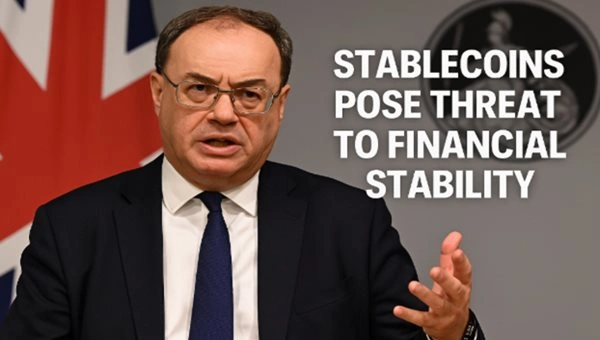

Bailey, also chair of the global Financial Stability Board (FSB), said the concern goes beyond stability. “Stablecoins are proposed to have the characteristics of money…they do have to maintain their nominal value,” he stated. He underscored that without robust backing, redeemability, and regulatory oversight, these tokens could fail to meet essential functions of money.

Rather than handing banks the green light to issue their stablecoins, Bailey proposed tokenized commercial bank deposits as a safer, regulated alternative. These digital deposit tokens would follow existing banking frameworks, fully backed, ring-fenced, and loan-eligible.
This route preserves credit creation linked to bank lending, a foundational pillar of modern economies.
Bailey’s posture reflects growing international wariness. The Bank for International Settlements (BIS) released a report in late June stating that stablecoins fail key money tests, including singleness, elasticity, and integrity, and flagged risks of illicit use and volatile redemptions.
The BIS also backed tokenized deposits, citing efforts like Project Agorá involving major central banks, including the BOE.
ECB President Christine Lagarde has similarly warned that stablecoins could undermine policy consistency and national sovereignty.
UK vs US: Diverging Strategies
The UK’s cautious stance stands in stark contrast to U.S. policy. Under President Trump, the Genius Act passed in the Senate, empowering commercial banks to issue fully reserved stablecoins, backed by Treasury bills, ostensibly to broaden the use of the dollar and lower federal borrowing costs. Treasury Secretary Scott Bessent described stablecoins as extensions of U.S. dollar supremacy; Fed Chair Powell also endorsed the push for regulatory clarity.
This regulatory split puts the UK at odds with the U.S. and the EU, both pursuing a more embracing of digital currencies, but with distinct flavors. The EU’s MiCA policy seeks strict licensing and capital requirements for stablecoins, while the ECB moves forward on a digital euro.
Historical Warnings and Real-World Precedents
Bailey noted that reliance on private stablecoins echoes past financial crises. The collapse of TerraUSD in 2022, where an algorithmic stablecoin lost its peg and wiped out billions, is a stark reminder of the fragility of non-backed digital money.
Similarly, concerns grow over stablecoins funneling funds outside regulated systems during turmoil.
Echoing this, BIS reports highlight stablecoins’ lack of central bank lender-of-last-resort support and limited elasticity, unlike traditional money, exacerbating risks in stressed conditions.
A Broadening Global Debate
Across Asia, regulators from South Korea to the Bank of Korea are voicing alarm about private stablecoins undermining national monetary policy. Emerging and developing nations also fear “digital dollarization,” where citizens bypass local banks and currencies in favor of dollar-pegged stablecoins, potentially destabilizing local economies.
Countries including China, Singapore, and the UAE are rolling out varying frameworks; some welcoming, others restrictive— highlighting divergent global strategies.
Looking Ahead: What’s at Stake?
Regulation vs Innovation
Supporters of stablecoins claim they offer faster payments, financial inclusion, and global utility. Critics contend that heavy regulation, reserve backing requirements, and licensing are non-negotiable for their systemic incorporation.
Central Banks’ Role
Central banks must choose between promoting tokenized existing deposits and issuing their CBDCs. Bailey himself remains skeptical of a “digital pound,” preferring private-sector tokenization under regulation.
Financial Stability vs Global Influence
The U.S. sees stablecoins as tools of dollar dominance; Europe and the UK frame them as threats. The question: Can private stablecoins scale without destabilizing trusted banking systems?
Our Take
Bailey’s cautionary message is clear: private stablecoins risk draining liquidity, weakening credit, and undermining the integrity of money. Unless tightly regulated or shunned by mainstream banks, the growing stablecoin ecosystem could evolve into a parallel financial system, one susceptible to runs, asset fire sales, and monetary fragmentation.
His advocacy for tokenized deposits offers a measured path: embracing the benefits of digital finance while retaining the protections and economic functions of traditional banking.
As lawmakers in Washington, Brussels, and beyond draft the regulatory future, Bailey’s message underscores a fundamental tension: how to innovate without destabilizing the bedrock of trust in money and credit.
He has worked with several companies in the past including Economy Watch, and Milkroad. Finds writing for BitEdge highly satisfying as he gets an opportunity to share his knowledge with a broad community of gamblers.
Nationality
Kenyan
Lives In
Cape Town
University
Kenyatta University and USIU
Degree
Economics, Finance and Journalism


Facts Checked by Vlad Hategan

 Fact checked by
Fact checked by 
 eabungana@gmail.com
eabungana@gmail.com 